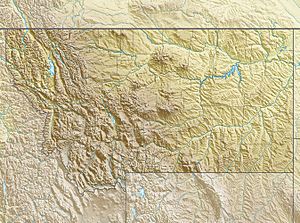Little Thompson River (Montana) facts for kids
Quick facts for kids Little Thompson River |
|
|---|---|
|
Location of the mouth of the Little Thompson River in Montana
|
|
| Country | United States |
| State | Montana |
| County | Sanders County |
| Physical characteristics | |
| Main source | Lolo National Forest, Montana 47°45′27″N 114°45′14″W / 47.75750°N 114.75389°W |
| River mouth | Thompson River 47°43′46″N 115°01′46″W / 47.72944°N 115.02944°W |
| Basin features | |
| Tributaries |
|
The Little Thompson River is a cool stream located in Sanders County, Montana. It's like a smaller helper river, also known as a tributary, that flows into the bigger Thompson River. The Thompson River then joins the even larger Clark Fork River.
This river is an important part of the natural environment in Montana. It provides water and a home for many plants and animals.
Contents
About the Little Thompson River
The Little Thompson River is a natural waterway that winds through the beautiful landscapes of Montana. It's not a very long river, but it plays a key role in the local water system. Rivers like this are essential for the health of the land around them.
Where Does It Start?
The Little Thompson River begins high up in the Lolo National Forest. This area is known as its headwaters. Imagine tiny streams and melting snow coming together to form the very beginning of the river. Many smaller creeks and streams flow into it, making it grow bigger as it travels.
Where Does It Go?
As the Little Thompson River flows, it eventually meets and joins the Thompson River. This meeting point is called its mouth. From there, the water continues its journey. The Thompson River then flows into the mighty Clark Fork River, which is a major river in the western United States.
What Creeks Join It?
Many smaller streams, called creeks, contribute their water to the Little Thompson River. These creeks help keep the river flowing strong. Some of the creeks that join it from the left side are Nancy Creek, McGinnis Creek, Corona Creek, and Mudd Creek.
On the right side, you'll find creeks like Alder Creek, Tepee Creek, Cabin Creek, Snider Creek, North Fork Little Thompson River, Little Rock Creek, and Marten Creek. All these smaller waterways create a network that feeds the main river.
Why Are Rivers Important?
Rivers like the Little Thompson River are super important for many reasons. They provide fresh water for wildlife, including fish, birds, and other animals. They also help shape the land, creating valleys and carrying nutrients.
For people, rivers can be sources of drinking water and places for fun activities. They are vital parts of our planet's natural systems.


